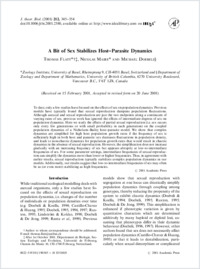A Bit of Sex Stabilizes Host+Parasite Dynamics
- Flatt, Thomas University of Basel
- Maire, Nicolas University of Basel
- Doebeli, Michael University of British Columbia
-
2001
Published in:
- Journal of Theoretical Biology. - 2001, vol. 212, no. 3, p. 345-354
English
To date, only a few studies have focused on the effects of sex on population dynamics. Previous models have typically found that sexual reproduction dampens population fluctuations. Although asexual and sexual reproduction are just the two endpoints along a continuum of varying rates of sex, previous work has ignored the effects of intermediate degrees of sex on population dynamics. Here we study the effects of partial sexual reproduction (i.e. sex occurs only every few generations or with small probability in each generation) on the coupled population dynamics of a Nicholson–Bailey host–parasite model. We show that complex dynamics are simplified for high host population growth rates if the frequency of sex is sufficiently high in both host and parasite: sex decreases fluctuations in population density, and leads to non-chaotic dynamics for population growth rates that would result in chaotic dynamics in the absence of sexual reproduction. However, the simplification does not increase gradually with an increasing frequency of sex but appears abruptly at low-to-intermediate frequencies of sex. For some parameter settings, intermediate frequencies of sexual reproduction can simplify the dynamics more than lower or higher frequencies. Thus, in agreement with earlier results, sexual reproduction typically stabilizes complex population dynamics in our models. Additionally, our results suggest that low-to-intermediate frequencies of sex may often be as (or even more) stabilizing as high frequencies.
- Faculty
- Faculté des sciences et de médecine
- Department
- Département de Biologie
- Language
-
- English
- Classification
- Biological sciences
- License
- License undefined
- Identifiers
-
- RERO DOC 324281
- DOI 10.1006/jtbi.2001.2380
- Persistent URL
- https://folia.unifr.ch/unifr/documents/307658
Statistics
Document views: 63
File downloads:
- 2001_bss.pdf: 162
